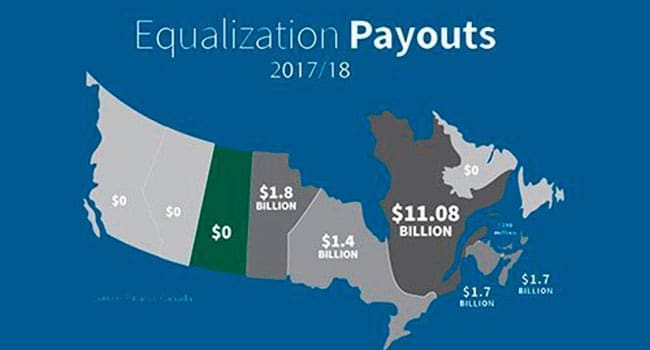By Ben Eisen
and Joel Emes
The Fraser Institute
The relative economic strength of Canada’s provinces has shifted in recent years, as former powerhouses struggle while former laggards improve. The nation’s equalization program is not equipped to respond fairly to these developments.
In the past two fiscal years, Quebec has collected more revenue from natural resources than Alberta. This may be stunning to some, but it’s symbolic of a broader trend: provinces that receive equalization payments have generally seen their ability to generate revenue improve more than provinces that don’t receive payments.
We’ve seen dramatically divergent trajectories in fiscal capacity between have and have-not provinces. Fiscal capacity refers to a province’s ability to raise revenue through provincial taxes. It’s linked to overall economic performance and is the metric used to determine who gets equalization payments and how much.
Over the past two years, the fiscal capacity (including all natural resource revenues) of the four provinces that don’t receive equalization (British Columbia, Alberta, Saskatchewan, and Newfoundland and Labrador) has collectively shrunk by 3.5 per cent. By comparison, the six have-not provinces have seen their fiscal capacity rise collectively by 8.1 per cent.
The gap between richer and poorer provinces has been shrinking.
One might think that if this trend continues, equalization payments would also start to shrink. But they won’t, due to a relatively new policy that requires the payments to grow in line with national gross domestic product (GDP) – even if the gap between richer and poorer provinces continues to become smaller.
How did this counter-intuitive policy come to exist? The rule pegging the growth rate of the overall equalization envelope to GDP growth was introduced 2009. It’s an effort to slow the growth in equalization program costs, which were in danger of skyrocketing due to high energy resource prices and Ontario’s transition to a have-not province.
Given the speed at which equalization costs were rising and the state of federal finances (there was a large deficit in 2009), there were good reasons for Ottawa to constrain program costs by putting a ceiling on the rate of equalization’s growth.
However, the mechanism used to create this ceiling – pegging the rate of equalization growth to national GDP growth – is on the cusp of creating a perverse outcome. As the rule is interpreted by the federal government, it can force equalization payments to become larger than they would be in its absence, if the gap between richer and poorer provinces shrinks sufficiently. In fact, we project this will occur as soon as next fiscal year.
So a rule designed to constrain costs will soon act as a cost driver.
This raises important questions about fairness. Taxpayers in provinces struggling economically, but with fiscal capacity still too high to receive equalization payments, will be disadvantaged by a rule that artificially drives up equalization payments beyond what they would be in its absence.
There is precedent for allowing equalization payments to shrink when fiscal capacity gaps narrow (this happened in the early 2000s). The rule requiring equalization to grow every year is of recent vintage.
Unfortunately, equalization remains a touchstone of regional tension. A rule requiring payments to grow – even if provinces such as Alberta and Saskatchewan, that contribute and receive no payments, continue to struggle – can only exacerbate regional friction.
The federal government can avoid this outcome by reforming the rule that requires payments to grow even if the economic gap between rich and poor provinces shrinks.
Ben Eisen and Joel Emes are analysts with the Fraser Institute and co-authors of Should Equalization Keep On Growing in an Era of Converging Fiscal Capacity?
Ben and Joel are Troy Media Thought Leaders. Why aren’t you?
The views, opinions and positions expressed by columnists and contributors are the author’s alone. They do not inherently or expressly reflect the views, opinions and/or positions of our publication.



